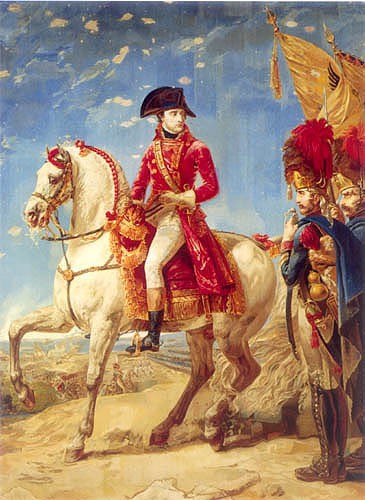After difficult years during the Revolutionary period, from 1805 the Gobelins manufactory benefitted from commissions from Napoleon destined for the decoration of the Imperial residences or as diplomatic gifts. Not concerned with being original, the weavers turned for their models to the great artists in the pay of the regime, choosing to copy the paintings which best served Imperial propaganda. Here the model was the painting by Gros today held in the Musée national de Malmaison, The First Consul distributing honour sabres after the Battle of Marengo. This great work was painted in 1802 and bought by Geneal Bessières. It shows the First Consul at a troop review on 27 Prairial, An VIII (16 June, 1800), at the camp in San Giuliano-Vecchio, distributing awards to the bravest soldiers, two days after the battle.
For the equestrian portrait of Bonaparte, Gros adapted the official portrait which the First Consul had commissioned from him in 1802. This explains Napoleon's slightly artificial pose on horseback, especially the ugly twisting of the torso. But despite its imperfections, this painting was highly praised by Gros's contemporaries, particularly by his master, David. Delécluze reported how David “was not afraid to say to a full Salon that this work […] would have a salutary effect on the work of the Paris school, where colour was much neglected.” Délécluze also noted that “Girodet, Gérard and all the painters of renown were unanimous in their vaunting of Gros's merits […]”. The vivacity and freshness of the colours in this work have ben particularly well transferred to the tapestry. But the mere copy of an existing work did not please the Emperor at all. From Berlin, he wrote in 1806: “Forbid the Gobelins Manufactory to make copies of paintings which they cannot hope to rival. Let them make hangings and furniture”. Fortunately, this order does not seem to have been heeded, since many works by David, Gérard, Regnault and Serangeli were copied by the manufactory. This tapestry of Gros's painting was completed in December 1810 and offered as a New Year gift to Queen Hortense in 1811. One of Gros's masterpieces, The Plague Victims at Jaffa, was also copied by the manufactory.
Karine Huguenaud (tr. P.H, ed. A.M)
June 2005
Bonaparte, First Consul, distributing honour sabres to the grenadiers of his guard after the Battle of Marengo, 14 June, 1800
Artist(s) : GROS Antoine-Jean (after)

- Date :
- 1806-1810
- Technique :
- vertical weave, wool and silk
- Dimensions :
- H = 3.13 m, L = 2.40 m
- Place held :
- Paris, Mobilier national
- Photo credit :
- © Mobilier national - F.Baussan

